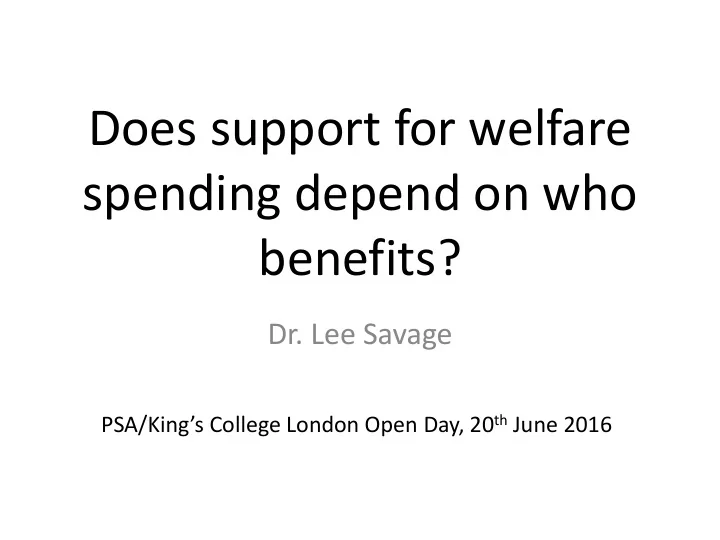

Does support for welfare spending depend on who benefits? Dr. Lee Savage PSA/King’s College London Open Day, 20 th June 2016
Welfare spending in context Welfare states are expensive, therefore, they are reliant on popular support to be sustainable. Welfare states were originally designed to support the economically disadvantaged in society and to alleviate the hardship people suffered during difficult times e.g. periods of unemployment. But the ‘typical’ client of the welfare state has changed over time, which may have had an impact on popular support for the welfare state.
Social expenditure 1. Public social spending is worth 22% of GDP on average across the OECD Public social expenditure as a percent of GDP, 2007, peak level after 2007, and 2014 1,2 35 2014 ( ↘ ) Peak level after 2007 2007 30 25 20 15 10 5 0 Source: OECD Social Expenditure database, 2014 Office for Budget Responsibility estimated that welfare spending in the UK mounted to £410bn in 2014.
What determines support for welfare spending? • Values and ideology • Religion • Beliefs about fairness • Economic status • Education Group membership (including ethnicity, nationality, citizenship) – to what extent are welfare recipients like me?
Immigration and support for welfare spending The impact of immigration on welfare spending is controversial. Some claim that immigration has led to increased welfare spending, others claim that migrants contribute more to the welfare state than they take out. Do perceptions of the impact of immigration change people’s support for welfare spending? Can the framing of the issue have an effect on support for welfare spending?
Framing and individual policy preferences The way an issue is framed can have an effect on economic policy preferences. Support for government stimulus among different income groups depends on framing of the policy: 1. Support among low income group increases when the stimulus is presented as a “boost” to the economy 2. Support among high income group increases when it is presented as “preventing economic collapse” (Malhotra and Margalit, 2010) Opinions on strictness of eligibility for unemployment benefits varies depending on perceptions of how much effort recipients are making to find work. (Petersen et al., 2012) People are more likely to support cuts to welfare spending when emphasis is placed on the effect such spending has on the budget deficit. (Marx and Schumacher, 2016)
Framing the impact of immigration on welfare spending Survey experiment. (3,000 adults, nationally representative sample) Respondents randomly assigned to one of three groups: 1. Receives no information about the impact of immigrations. (Control group) 2. Receives positive information: “Research has shown that immigrants cost the taxpayer £8,350 a year in healthcare, education, and benefits.” 3. Receives negative information: “Research has shown that immigrants contributed £20 billion more in taxes than they received in welfare payments between 2000 and 2011.”
The key question Many social benefits and services are paid for by taxes. Which of the following goals do you personally think the government should prioritise? 1. Spending significantly more on social benefits and services even if this leads to significantly higher taxes. 2. Spending slightly more on social benefits and services even if this leads to slightly higher taxes. 3. Reducing taxes slightly even if this leads to slightly less spending on social benefits and services. 4. Reducing taxes significantly even if this leads to significantly less spending on social benefits and services. 5. Neither; social benefits, services and taxes should be left as they are right now.
Support for social spending versus cutting taxes .5 0.46 .45 0.43 .4 0.39 .35 - Negative frame Positive frame Control group -
Conclusions and implications Negative framing works. Positive framing may have the opposite effect to that intended. Could have implications for the way some groups present their side of the argument. Limits of the study: 1. Data analysis still not complete, results are preliminary. 2. We don’t know if the result is permanent.
Recommend
More recommend